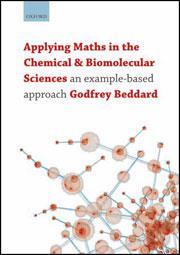Applying maths in the chemical and biomolecular sciences
Applying maths in the chemical and biomolecular sciences: an example-based approach
Godfrey Beddard
Oxford, UK: Oxford University Press 2009 | 786pp | ?29.99 (SB)
ISBN 9780199230914
Reviewed by Paul Yates
I am always somewhat sceptical of claims by authors of mathematics textbooks that they are suitable to support a range of degrees. However, in this case my fears were ungrounded and I found much material of chemical relevance.

The book is aimed at final year undergraduate and postgraduate students, but I actually felt that there was much material here that would be of use at a more introductory level. Topics such as logarithms, factorials and SI units are treated in the first chapter, while the early parts of more specialised chapters on topics such as differentiation and vectors could be selected for use in an introductory course. This is balanced by chapters on Fourier series and Monte Carlo methods which are more likely to be of specific interest only.
The A4 format of the book, together with the use of frequent line drawings, helps to increase its accessibility. Sets of questions frequently appear at the end of sections within chapters, with a more substantial set of questions appearing at the end of each chapter. These include many applied questions that will be of interest to chemists and which go beyond those normally found in similar books. For example, there are questions on buffer capacity and racemisation of biphenyls that I hadn’t seen before.
Many of the questions are accompanied by a brief strategy to assist the reader, and full solutions for all of them are available on an accompanying website. Maple syntax is included throughout, which will be of use to some readers but won’t be too distracting otherwise.
This book will be a useful resource to anyone who teaches mathematics to chemists and the target audience of advanced students. Some material could also be considered for use with students at a less advanced stage.












No comments yet